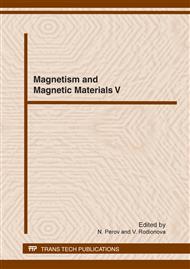p.417
p.421
p.425
p.429
p.435
p.439
p.443
p.447
p.451
Magnetic Properties and Thermal Stability of xFe (100-x)SiO2 (x=5-95) Powder Nanocomposites
Abstract:
The study of Fe/SiO2 nanocomposites magnetic properties and structure relationships was performed in dependence on Fe to SiO2 relative concentration and type of precursors preparation (mechanical mixing or ultrasonic homogenization). Thermal metallization method in hot hydrogen of initial reagents [хFeOOH and (100-x)SiO2] was applied for nanocermets production. It was determined that formation of air-tight shell on the particles surface affects the nanocomposites magnetization values and their air temperature stability.
Info:
Periodical:
Pages:
435-438
Citation:
Online since:
June 2012
Price:
Сopyright:
© 2012 Trans Tech Publications Ltd. All Rights Reserved
Share:
Citation:


